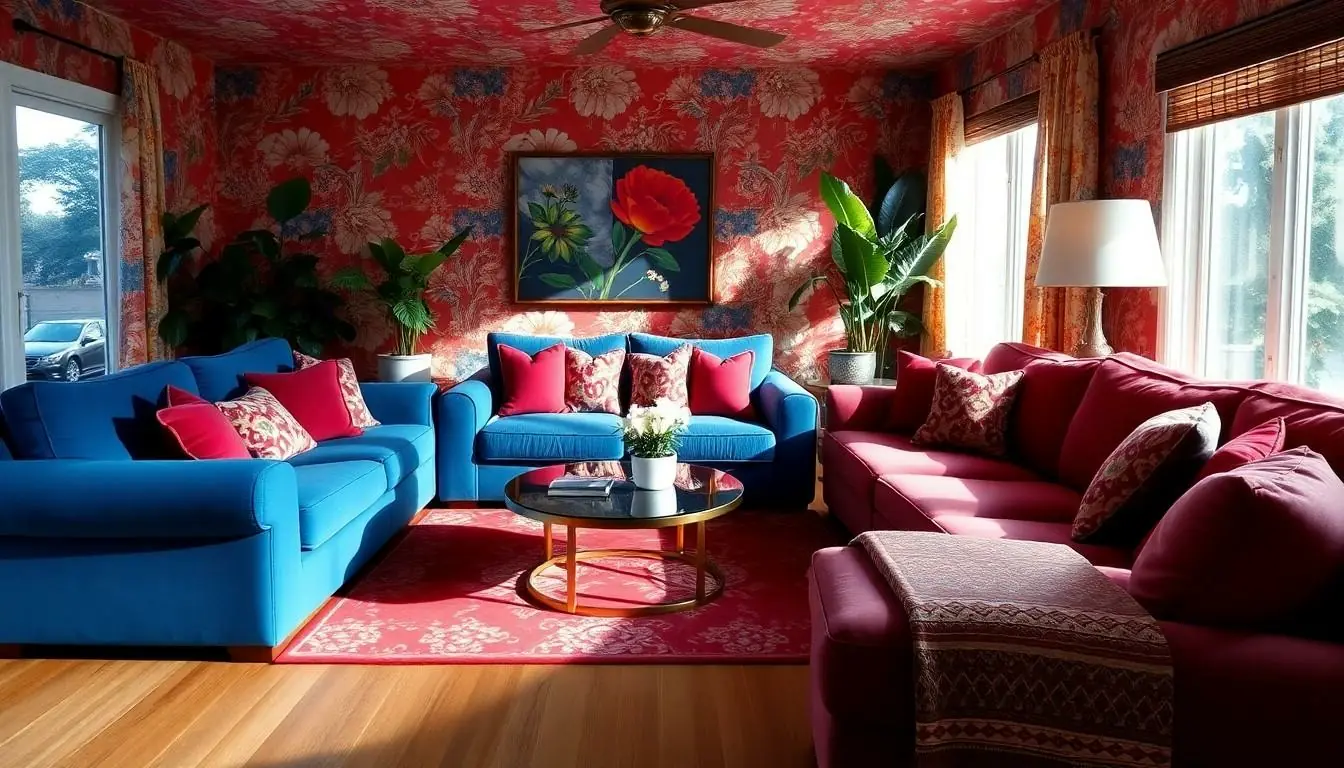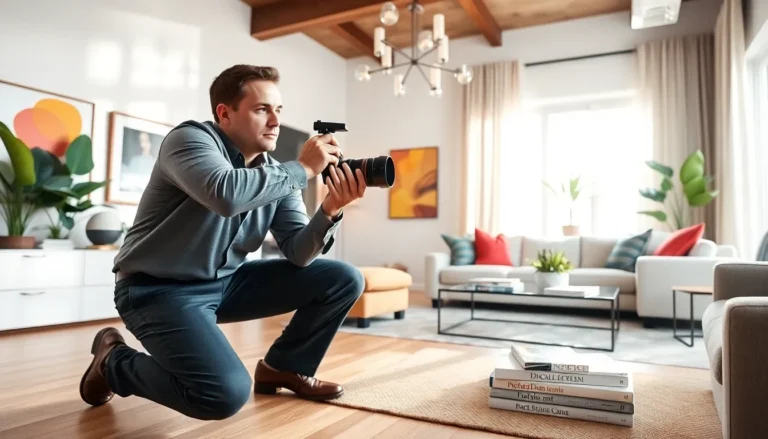Step into a time machine and let’s rewind to the glorious 90s, where living rooms were a vibrant tapestry of bold colors, eclectic patterns, and a hint of nostalgia. Remember the oversized couches that could comfortably seat a small army? Or the iconic floral prints that could make even a wallflower feel like a superstar? The 90s interior design wasn’t just about aesthetics; it was a lifestyle statement, a celebration of individuality, and a playground for creativity.
Table of Contents
ToggleOverview of Living Room 90s Interior Design
Living room design from the 1990s showcased a mix of bold aesthetics and comfort. Vibrant colors dominated the palette, often featuring deep blues, bright greens, and rich reds. Oversized furniture played a crucial role, with large sofas and armchairs inviting relaxation and conversation.
Patterns emerged as a defining feature in 90s interiors. Plaids, florals, and geometric designs frequently adorned fabrics, wall coverings, and rugs. Wallpaper often featured large prints, creating striking visual effects that contributed to the overall atmosphere of the living space.
Eclecticism became popular, reflecting individual personality and creativity. Homeowners combined various styles, incorporating vintage pieces alongside modern accessories. This approach provided uniqueness and character to each living room.
Technology also influenced design choices in the 90s. Entertainment centers grew in size to accommodate large televisions and audio equipment. These centers were often focal points, featuring built-in shelving and decorative elements.
In addition, natural elements gained popularity. Using wood, wicker, and stone brought warmth to living spaces, enhancing the connection with nature. Indoor plants flourished in this design era, contributing to a fresh and lively ambiance.
Overall, living room design in the 1990s represented self-expression and bold choices. It balanced comfort and aesthetics, shaping a distinct cultural landscape that remains impactful today.
Key Characteristics

The 1990s living room design stands out with its vibrant atmosphere and unique styles. This era introduced various distinct elements that created a memorable aesthetic.
Color Palettes
Bright colors defined 90s living rooms. Bold blues, lively greens, and deep reds frequently adorned walls and furnishings. Homeowners embraced eclectic color combinations, showcasing personality through contrasting hues. Additionally, pastels like soft lavender and peach offered softer alternatives. These palettes produced dynamic spaces, inviting warmth and energy into the home.
Furniture Styles
Oversized furniture became synonymous with 90s interior design. Spacious sofas and substantial armchairs encouraged relaxation and social interaction. Fabric choices included plush velvets and durable cotton blends, emphasizing comfort. Shaker-style and modern pieces often coexisted, demonstrating a balance of tradition and contemporary flair. Movable seating arrangements allowed for versatility while enhancing the room’s aesthetic.
Decor Elements
Decorative elements added character to 90s living rooms. Large-print wallpapers transformed walls into striking focal points, while mosaic tile designs created visual interest. Decorative accents such as patterned throw pillows, quirky art prints, and crafted wooden accessories embraced personalization. Indoor plants also flourished, providing a lively connection to nature. Overall, these elements contributed to a distinctive interior that reflected both style and individuality.
Popular Trends in the 90s
The 1990s marked a unique era in interior design, characterized by bold choices and personal expression. This section explores the key trends that defined living rooms during this vibrant decade.
Sofa Designs
Sofa designs from the 90s embraced comfort and scale. Large, plush sofas became the centerpiece, inviting relaxation and conversation. Many featured intricate upholstery, showcasing materials like velvet and chenille. Overstuffed cushions offered a lounge-worthy appeal, while design variations included sectionals and futons for flexible seating. Bold colors dominated, from deep jewel tones to pastel shades, reflecting individual style. Geometric patterns often adorned fabrics, adding a playful touch. Additional features included reclining mechanisms and multifunctional designs, meeting both comfort and practicality.
Wall Treatments
Wall treatments in the 90s created visually striking environments. Large-print wallpaper gained popularity, showcasing bold florals and abstract designs. Accent walls became trendy, often painted in vibrant hues or covered in textured wallpaper. Textured finishes like sponge painting and stenciling added depth to spaces. Additionally, murals and decals offered a creative means of personalizing walls. For a cozy feel, wood paneling or wainscoting appeared in many homes, integrating natural elements seamlessly. Subtle pastels provided balance, complementing brighter design choices while maintaining a warm atmosphere.
Influential Designers and Brands
The 1990s saw key designers and brands leave an indelible mark on living room interiors. These figures reshaped aesthetics and functionality to reflect the decade’s spirit.
Notable Contributions
Designers such as Philippe Starck and Michael Graves changed perceptions of everyday objects. Starck introduced playful forms and unexpected materials, while Graves combined humor with practicality in his designs. Additionally, brands like IKEA revolutionized affordable furnishings, offering modular and multifunctional pieces. Contributions from each of these designers and brands created a diverse marketplace where creativity thrived and individuality flourished.
Iconic Pieces
Iconic pieces from the 90s remain highly sought after today. The iconic Knoll Womb Chair, designed by Eero Saarinen, provided both comfort and style with its enveloping form. Another standout, the La-Z-Boy recliner, epitomized relaxation, offering a blend of functionality and leisure. Multi-use furniture items, such as futons and convertible sofas, captured the era’s trend of versatility. Each of these pieces exemplified 90s design’s commitment to merging comfort with vibrant aesthetics.
Nostalgia Factor in Modern Design
Nostalgia plays a significant role in shaping contemporary interior design. The influence of 1990s living room aesthetics can be seen in today’s trends, where bold colors and eclectic decor make a comeback. Designers embrace the rich palettes of the past, integrating deep blues, bright greens, and vibrant reds with softer pastels for a balanced feel.
Eclecticism remains popular in modern spaces, where vintage and contemporary elements blend seamlessly. Incorporating oversized furniture continues to invite relaxation, echoing the comfort found in 90s design. Plush fabrics and inviting colors enhance the cozy atmosphere.
Large-print wallpaper, a staple of 90s decor, resurfaces in current designs, offering visual interest and personality. Accent walls showcase creative uses of texture and pattern, reminiscent of sponge painting and stenciling once favored in living rooms. Designers often select retro-inspired artwork and accessories to celebrate this nostalgic aesthetic.
Natural materials make a strong appearance in modern interiors, harkening back to the emphasis on warmth found in the 90s. Wicker, wood, and stone connect spaces to nature, while indoor plants flourish, adding life and vibrancy. The integration of these elements enhances the inviting ambiance.
Technology influences design choices, with modern entertainment centers drawing inspiration from 90s furniture. Multifunctional pieces and modular layouts facilitate flexible spaces, highlighting efficiency and style. Overall, the fusion of nostalgia with contemporary design creates a personalized living environment that resonates with those who long for the aesthetics of the past.
The 90s interior design style offers a vibrant and eclectic approach that continues to inspire today’s living spaces. Its bold colors oversized furniture and unique patterns create an inviting atmosphere that resonates with those who appreciate personal expression. As contemporary designers draw from this nostalgic era they embrace the playful aesthetics and comfort that defined the decade.
By blending the past with modern sensibilities homeowners can create living rooms that reflect their individuality while maintaining a cozy and welcoming environment. The enduring influence of 90s design serves as a reminder that style evolves but the essence of comfort and creativity remains timeless.



